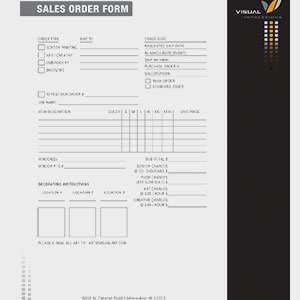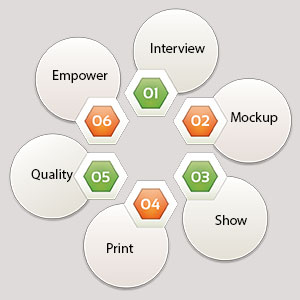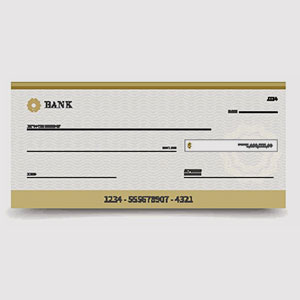Strategy May 25, 2015
The Perfect Order
In an industry where creativity and customization are expected every day, a lot can go wrong. Here is how to make each order absolutely perfect.
Yes, we know nobody’s perfect. To err is human, and all that. When you’re in the business of putting together custom orders, there’s plenty of opportunity to prove the truth of Alexander Pope’s timeless statement.
But what about those weeks when everything goes just right, from the moment you snag a new prospect to the time the flawlessly decorated goods are sent out the door? We envisioned a scenario like this, breaking down each step of the process, with expert tips on how to bring your shop a few steps closer to procedural utopia. This is The Perfect Order.
The Perfect...Customer

Mind for Details: Clients who are thorough and detail-oriented can be a joy to work with, decorators say. “It’s critical that our clients cross their T’s and dot their I’s,”says Steve Kanney, president and owner of Target Decorated Apparel (asi/90549) in Naperville, IL. “Otherwise, it can be a very, very painful process.”
Good Eyes: “Our ideal customer demands a quality garment, paired with the right inks,”says Rich Santo, president of Culture Studio (asi/700559) in Chicago. “We enjoy someone who is looking for some innovations in their apparel marketing.”
Clear Voice: The best customers have an idea of what they want, even if they don’t know how to achieve it. “Be the opposite of the customer that comes into the project saying,‘Just wow me.’ That is not direction,”says Bill Patterson, vice president of sales at HTT Apparel & Headwear (asi/58842) in Murrieta, CA.
Open Ears: Though it’s best when clients are prepared and have a plan for their apparel, they also have to be willing to listen to your expertise, especially if their vision is not cost-effective, or is impossible to achieve using their preferred decoration method. “It’s about establishing good communication,”says Erich Campbell, of Black Duck Embroidery and Screen Printing in Albuquerque, NM.
Thumbs Up: Enthusiasm goes a long way. “Our ideal customer is someone who is excited about the products that we offer. The great thing about our industry is that we have such a variety of customers,”says Brandy Ferguson, apparel operations supervisor for Trimark Powered By Leeds (asi/66888).
Full Wallet: This doesn’t mean the customer has to be rich and extravagant, but a good customer can afford – and appreciates – quality goods and service. “Ultimately, the ideal customer is the one for whom we can provide value, and who respects and is willing to pay for the skills and capabilities we bring to the table,”Campbell says.
The Perfect...Cold Call
Few people enjoy cold-calling, preferring “warmer”options like referrals or LinkedIn introductions. But even in today’s cyber-connected world, there are still times when an old-school cold call works best. Offering a great product is not a way to differentiate your company; consumers expect nothing less, says sales trainer Dave Mattson, CEO and president of Sandler Training, based in Owings Mill, Maryland. One way to stand out from the crowd is to develop a solid cold-call strategy, since many competitors avoid them like the plague, he adds. “You never outgrow business development,”Mattson says. “That’s the lifeblood of your business.”
If fear of the unknown is keeping you from picking up the phone, try developing a script, like the exchange below, to help get you started.
Rita, Perfect Apparel Sales Rep: “Good morning, Susan. I’m Rita from Perfect Apparel, and I’m looking for a little help. I’m not even sure if you and I should be talking. Could I spend about two minutes to tell you a little bit about who we are and what we do, and then you can decide whether it makes sense to talk?”
Susan from Company X: “Well, I guess I have two minutes. Sure, go ahead.”¹
Rita: “Perfect Apparel creates custom apparel and branding solutions for a wide range of clients, anything from polos and T-shirts to mugs and pens. We work with executives like yourself who were frustrated with the poor quality and slow turnaround time of their previous vendors. We’ve heard from clients who received T-shirts in the wrong sizes and colors. Others received their items late or their orders were incomplete. And when they called for an explanation the printer only had excuses. Of course, every situation is different. I don’t know if you’ve experienced any of that type of thing…”
Susan: “Well, actually, yes.”
Rita: “Oh, no. Tell me what happened.”
Susan: “We ordered three dozen T-shirts for a fundraising event last year. We wanted all employees representing our company to present a unified front, so to speak. The vendor assured us they’d be done well before the event, but they didn’t arrive until the day before, and the shirts were all the wrong color.”
Rita: “What did you do?”
Susan: “I called the shop, and they said it was too late to fix the problem. They refused to give us a refund or do anything to make it better.”
Rita: “I’m so sorry to hear about that. I’d love to set up a longer call, when you have more time, to talk about how Perfect Apparel ensures mistakes like that don’t happen and the other services we offer our clients.”³
Susan: “OK. Let me check my calendar.”
1: Mattson calls this opening salvo a “pattern interrupt.”It works, psychologically, because people generally like to help others, he adds. Rita boxed her initial pitch into an easily digestible two-minute chunk and gave Susan total control to decide whether to continue after that. “People appreciate that,”Mattson says.
2: Once you’ve set the parameters of the call, you can launch a 30-second commercial, sharing a few basic facts about your company, but don’t overdo it, Mattson says. Pick your company’s three strong points – in Rita’s case, Perfect Apparel prides itself on quality, customer service and quick turnaround time – and share some of the biggest frustrations you’ve heard about your current clients’ previous experiences. “Paint a picture of frustration from the prospect’s side,”Mattson says. “Then get quiet. …Salespeople have two ears and one mouth. Use them in the proportion that they’re given to you.”
3: Once you’ve identified a prospect’s pain points, you become “the doctor of sales,”Mattson says. “Ask all the questions that a doctor would ask you when you first visit them with some sort of ailment,”he advises. “Now you’re gathering information and being a consultative salesperson.”
The Perfect...Work Order

It’s essential that every aspect of an order is clearly written down, with enough information for everyone involved in the process. “If anybody in production has to walk up front and say, ‘Hey, what does this mean?’ then you haven’t filled it out correctly,”says Marshall Atkinson, chief operating officer at Visual Impressions in Milwaukee, WI. “You have to give absolutely crystal clear expectations about what will happen.”The busier the shop, the longer the work order should be, because there’s less time to deal with each job, he adds. “It’s actually a living document,”Atkinson says.
These are the key features of the work order:
1. Ship Date and In-Hands Date: The Ship Date is the day the job is scheduled to leave the building. The In-Hands Date is the date when the job is to be delivered. After order entry, every other department that touches the job uses these dates to prioritize their work based on only one idea: how much time is needed to start the order and finish so it can leave on the ship date as intended. Everyone checks the system constantly, looking ahead for jobs a few days to a week out that are going to impact their departments.
2. Purchase Order Number: Besides being a way to track the order, the order number (123456 for example) does so much more. Use it to print a label on all boxes that pertain to the job. Also, in receiving, stage partially-received jobs in areas that correspond to the last digit of the work order number. In production, do the same. The last digit enables stacking the inventory in rows by number, and anyone can find and locate the inventory when needed.
3. Item Description: Make sure there is ample room to include garment style numbers, colors, gender and the sizing breakdown, says Brandy Ferguson of Trimark Powered by Leeds (asi/66888). “These are the most common areas to have a discrepancy,”she adds. Be specific, using Pantone colors rather than just eyeballing it, so that everyone is on the same page.
4. Decorating Instructions: Be sure to specify art dimensions and location information (such as distance in inches from the collar or other landmark). Rely on shop standards that are instilled in the staff, so that everyone knows exactly what is meant by, for example, full-front image size (perhaps it is 12”wide for adults). Train employees on the standards and hold them accountable by periodically auditing their orders, Atkinson adds.
Tip:Consider keeping all the information for a work order in a clear “job jacket,”as Visual Impressions does. On one side of the jacket, details on the order number, ship date, item quantities and other information are clearly visible. Flip it over, and you’ll see details about the decoration method and design info. The art mockup, packing slips and any other paperwork that doesn’t need to be referenced as often can be stuffed in the middle of the jacket.
The Perfect...Artwork

Better Art is Not a Myth:Most shops have horror stories of the mythical “cocktail napkin”scrawl that the customer wants transformed into an eye-catching T-shirt, but those cases have become less common with the democratization of design and software, says Erich Campbell of Black Duck Embroidery and Screen Print.
But Most Art Needs a Little Work:Still, it’s rare that a submitted design doesn’t have to be reworked on some level. Black Duck received that elusive perfect artwork when AMC TV submitted the logo below to be used on its series “Better Call Saul.”“They simply asked us to do the distressing of the image,”says Campbell, “so we created the distress patterns to suit their needs.”
Image Improvement Is Good:Campbell and company don’t mind when the artwork needs a little spit and polish. “Most customers, when given the option, prefer to have our artists work with and refine their art for use on apparel,”he says. “In this way, we can tailor the art not only to the technical needs of the medium, but to the needs of the customer both as it comes to their choice of garments and placement, but also as pertains to their budget.”
Ask for the Right Type:These are the two most readily accepted types of files:
Vector Files: For screen printing, a vector-based file is the best possible submission from a customer. A vector file is an image composed of paths and is made to be infinitely sharp and scalable. Even better, the artwork should have the proper colors assigned to it and all of its type converted from live fonts to vector shapes, with the font names listed, Campbell says.
Raster Files: A raster file is an image composed of pixels that is generally created in Photoshop. Decorators can also work with this type of file, though ideally such images should have a resolution of 300 dots per inch (dpi).
Tip: Target Decorated Apparel (asi/90549) published on its website a detailed rundown of file formats: those that are acceptable, those that may require additional art time and those that are unacceptable for production. The shop also outlines how both a vector and a raster file travel through the production process, going from raw artwork to a printed design. “We’ve tried to make it clean and easy to follow for our clients,”Kanney says. “We’ve also made it available in many places, so they can pass this along to their clients if need be.”Check it out at www.targetda.com/learning-center/artwork-readiness.
The Perfect...Approval Process

Step 1:Salesperson conducts a thorough interview with client to find out exactly what apparel and decoration is needed and when it must be completed. To prevent time-wasting miscommunications, put together a script or form for sales staff that spells out the minimum amount of information needed to fulfill each job
Step 2: Send the information to the art department, so staff can create a virtual mockup. For orders that include personalization, it’s a good idea to include virtual samples of all names and numbers to ensure no mistakes have been made in transcription.
Step 3: Either email the mockup or show it to client in-house to receive initial approval. The mockup should contain an image of the design on the garment (either on a model or flat) and perhaps a close-up of the design itself. Additional information such as dimensions of design and colors used can be added. Customers can approve simply by responding to the email or by clicking through an automated approval form.
Step 4: Create a sample print for internal approval of your salesperson and other staff.
Step 5: Set up a system of signatures with production staff to ensure quality control and double-checking of art details.
Step 6: Empower everyone on staff, from production to packaging, to report irregularities and mistakes. It’s better to replace a misprint before it leaves the building than to deal with an angry customer later.
Expert advice: “Double and triple check. The very notion of production is fraught with danger.” – Bill Patterson, HTT Apparel and Headwear (asi/58842)
The Perfect...Payment
Ideally, clients would pay in full either before or upon delivery of the goods, but that doesn’t always happen. Here is how some shops handle payment.

Earn Your Credit:“We keep new customers on a pre-production deposit and require their final payment on pickup of delivered goods. When they have ordered from us reliably, they can move to looser payment plans, requiring no deposit and having 30-day payment terms.”– Erich Campbell, Black Duck Embroidery and Screen Print

Opt for E-Commerce:“We prefer electronic payments, though we accept other forms such as checks and credit/debit cards. Payment requirements are governed by each customers’ payment terms.”– Brandy Ferguson, Trimark Powered by Leed’s (asi/66888)

Go Plastic:“Credit cards seem to be integrating into our business more and more. The client gets 30 days to pay their bill, and the factory gets the funds the next day or so. Seems like a win/win.”– Rich Santo, Culture Studio (asi/700559)

Cut the Check:“We try to extend 30-day terms to our clients when we can. We would much rather get paid via check than by credit card. The credit card companies are getting wealthy, and we’re having to digest 2% to 4% of an order. We don’t currently charge our clients the credit card fee unless they have used up our 30-day terms, and then still want to put it on a credit card.”– Steve Kanney, Target Decorated Apparel (asi/90549)
The Perfect...Delivery

The perfect delivery is the one that arrives to customers as soon as possible – on time and accurate. Standard lead times vary from shop to shop, often hovering around a week. Increasingly, however, time-strapped customers are demanding rush delivery, and most shops are willing to meet those needs – for a price.
1. Brandy Ferguson, Trimark Powered by Leeds (asi/66888):“We offer SureShip on decorated apparel, which means that if an order is placed by 5 p.m. EST, the completed order will ship out the following business day, with some exclusions.”
2. Erich Campbell, Black Duck Embroidery and Screen Print:“We keep a general one-week turnaround time, but allow regularly for rush orders with additional charges for the quickest turnarounds.”
3. Bill Patterson, HTT Apparel and Headwear (asi/58842):“Unfortunately, a thread of procrastination runs through the industry, and that, coupled with turnaround times, can mean in-hand dates are missed. … Whatever the reason for a delay, it can be avoided by anticipating and planning for the worst-case scenario. Sending a product directly to the end-user via air is an option, though expensive.”
The Perfect...Follow Up

The goods have been delivered without a hitch, but your work isn’t truly finished until you follow up with your client. Many experts recommend setting up an automatic emailing system to touch base with customers to find out if they are happy with your work. Keeping in regular contact is also a good way to ensure your shop is top of mind the next time a client is putting together an apparel order.
30-Second Case Study: Howard Potter, owner of A&P Master Images (asi/702505) in Utica, NY, believes his shop was able to double January sales this year – from $64,000 to $120,000 – thanks in part to detailed record-keeping and strategic prospecting. Sales reps at A&P keep track of previous orders and reach out to past clients the month before they’ve traditionally placed orders. Says Potter: “We started hitting them up in December to push for January.” It made for a happy new year at the shop.
